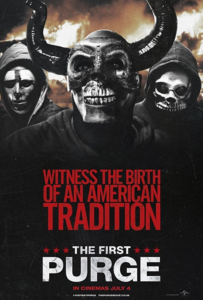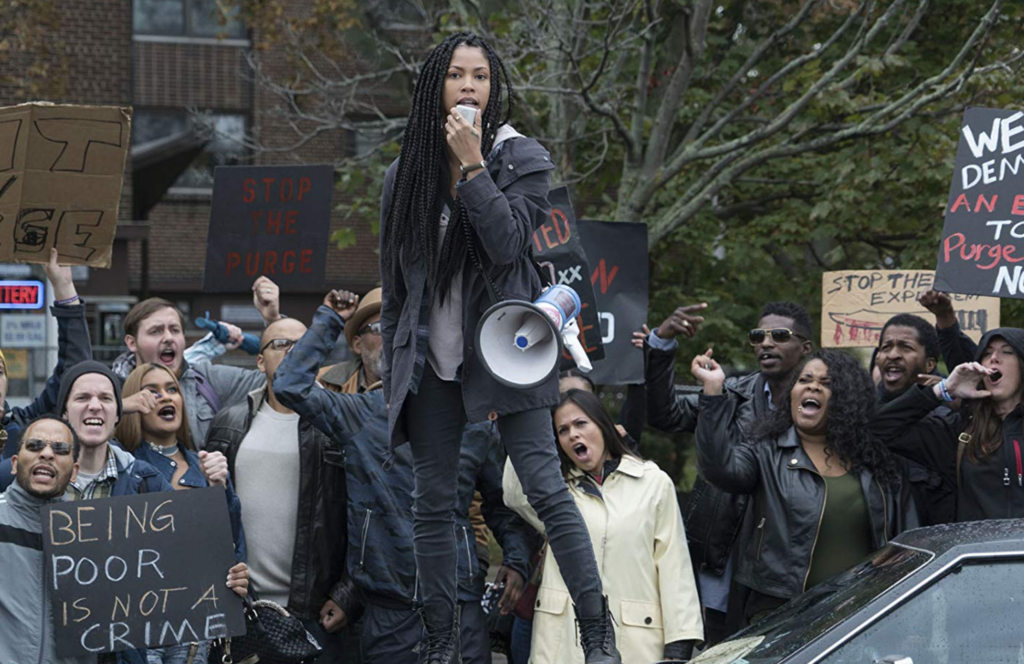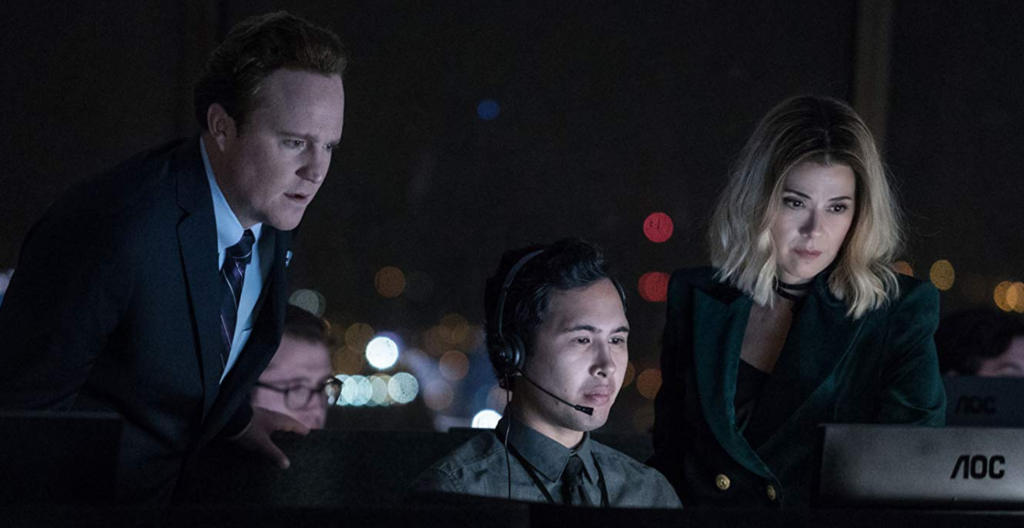The pilot for an upcoming 10-part television series, “The First Purge” is a violent, often incoherent, action/thriller that lacks the clever elements that made its predecessors work.
 The fourth in the modestly budgeted but blockbuster “Purge” series, “The First Purge” is a prequel that tells the origin story. Sadly, keeping the origin murky was probably a good idea, because instead of providing greater insight into the social experiment meant to dispel violent urges in the country, this film reveals that the whole idea is just a foolish folly. “The First Purge” is an ugly movie that plays on the worst stereotypes relying on thin satire to hide the inherent racism arguably behind the mythology that underpins the franchise.
The fourth in the modestly budgeted but blockbuster “Purge” series, “The First Purge” is a prequel that tells the origin story. Sadly, keeping the origin murky was probably a good idea, because instead of providing greater insight into the social experiment meant to dispel violent urges in the country, this film reveals that the whole idea is just a foolish folly. “The First Purge” is an ugly movie that plays on the worst stereotypes relying on thin satire to hide the inherent racism arguably behind the mythology that underpins the franchise.
As the United States struggles to contain crime and violence, the nation’s leadership has become more and more Fascist with the rise of a political party named The Second Founding Fathers. Of course, in this film, these politicians are pasty white guys driven by religious zeal. They latch o nto Dr. Updale (Marisa Tomei), who is the architect of a theory that argues that a period of lawlessness will cause the overall levels of crime to decline. The idea, I suppose, is like the opposite of the broken window theory of law enforcement, which Giuliani employed in an effort to reduce crime in New York City. But counterintuitively Updale’s theory is to let the people get crime and violence out of their system, and they’ll commit less crime throughout the year.
nto Dr. Updale (Marisa Tomei), who is the architect of a theory that argues that a period of lawlessness will cause the overall levels of crime to decline. The idea, I suppose, is like the opposite of the broken window theory of law enforcement, which Giuliani employed in an effort to reduce crime in New York City. But counterintuitively Updale’s theory is to let the people get crime and violence out of their system, and they’ll commit less crime throughout the year.
Anyway, we know all of this already—it’s called purging, right? Well, in this film, that is an evolving concept, and the term is just taking root in the popular culture lexicon. After an opening sequence in which we see news footage of people committing crimes and rioting (strangely with the faces of the people featured inconsistently censored), we are introduced to the cast of characters. This is another familiar franchise element.
 This first purge experiment is scheduled to take place on Staten Island. And to ensure a number of participants, the government agrees to pay anyone who remains on the island the paltry sum of $5,000.00 each, but more money can be made by those who commit violent acts. To monitor things, volunteers are outfitted with high-tech contact lenses that record and transmit in real time anything they see and do. Drones fly over the streets beaming footage to a control room that releases clips to the web.
This first purge experiment is scheduled to take place on Staten Island. And to ensure a number of participants, the government agrees to pay anyone who remains on the island the paltry sum of $5,000.00 each, but more money can be made by those who commit violent acts. To monitor things, volunteers are outfitted with high-tech contact lenses that record and transmit in real time anything they see and do. Drones fly over the streets beaming footage to a control room that releases clips to the web.
We meet muscled-up drug kingpin Dmitri (Y’lan Noel), who orders his men not to purge, while fortifying his headquarters against outside threats. His community nemesis is Nya (Lex Scott Davis), an activist determined to fight against the experiment and help those who remain peacefully in place. Of course, no one is required to stay, but when the killing starts, no one is allowed to leave.
 It’s completely ridiculous to the extreme, because in an experiment like this one, everyone would be compensated for any losses at the very least. Remember the concept of purge insurance floated in one of the earlier films. And in the first installment Ethan Hawke’s character made a living by armoring homes for the dangerous night of lawlessness.
It’s completely ridiculous to the extreme, because in an experiment like this one, everyone would be compensated for any losses at the very least. Remember the concept of purge insurance floated in one of the earlier films. And in the first installment Ethan Hawke’s character made a living by armoring homes for the dangerous night of lawlessness.
Into the mix in this film are sinister government forces that meddle in the experiment’s control group. And this means that the ultra-violence will reach unprecedented levels. After all, we’re now four films deep, and in order to top the last one, forget getting smarter, no, the way to go is to make the body count higher and everything more unnecessarily visceral. Unfortunately, instead of scary and provocative, this latest installment devolves into a low-rent actioner with Noel’s Dmitri morphing into an almost Marvel-esque superhero.
In a concluding sequence that qualifies as a blatant “The Raid: Redemption” ripoff, we get a series of repetitive and indistinguishable floor-by-floor gun battles. It’s baffling, as hand-to-hand combat is combined with unlimited machine gun fire. It becomes a cheap, comic-book fantasy as Dmitri fires guns with colorful flare holding them stylishly instead of realistically. The effect is an unhealthy fetishization of the gunplay and bloodletting. I wish that I could say that some deeper meaning is intended, but I came away entirely empty.
The televisual nature of the production is made clear during the end title credits when we get an actual commercial for the upcoming television series. This episode is the pilot, albeit premiering in theaters. And what a relief that is, because we aren’t likely to have to sit through another theatrical Purge offering. What started as an interesting and entertaining b-movie idea has evolved into the next violent series aimed squarely at “The Walking Dead” crowd.

